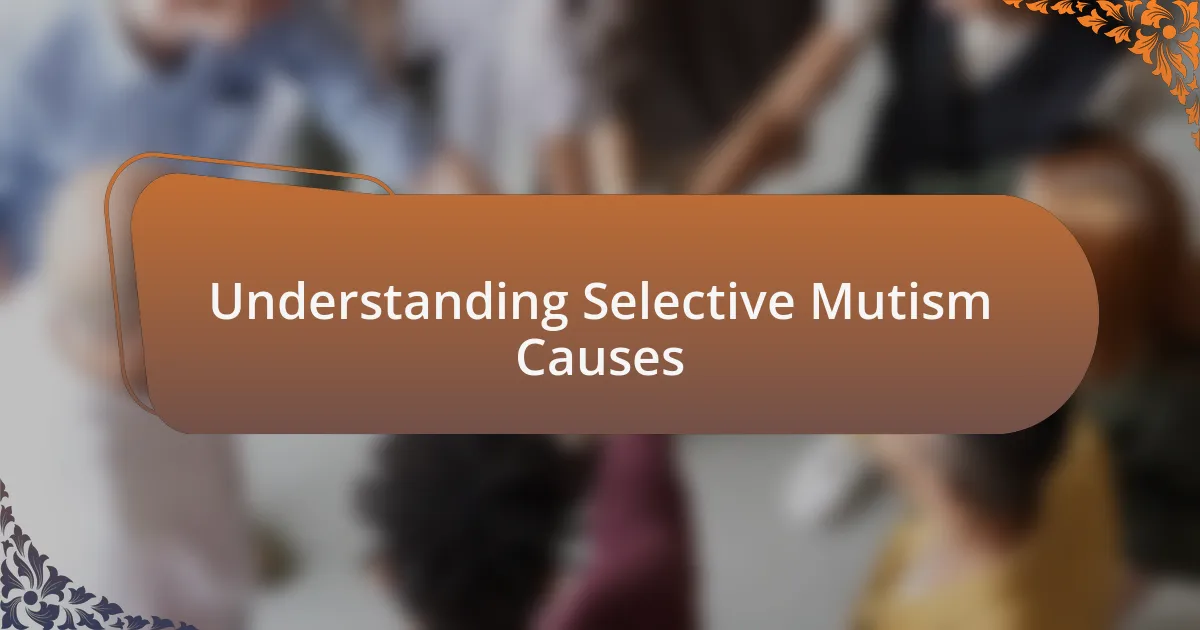Key takeaways:
- Selective mutism is an anxiety disorder where children can speak in comfortable settings but struggle to voice themselves in social situations, often due to shyness or social anxiety.
- Causes of selective mutism include genetic predisposition, temperament, and experiences of trauma or significant life changes, which can amplify feelings of fear.
- Effective strategies for overcoming selective mutism include gradual exposure to speaking, role-playing, and practicing breathing exercises to manage anxiety.
- Support networks, such as trusted adults, online forums, and professional therapy, play a vital role in helping individuals cope with selective mutism and build confidence.

What is Selective Mutism
Selective mutism is an anxiety disorder that primarily affects children, where they consistently fail to speak in certain social situations, despite having the ability to speak in more comfortable environments. I remember the frustration of wanting to speak up in class but feeling as if an invisible barrier was preventing me from doing so. Can you imagine standing among your peers, wanting to voice your thoughts, yet feeling completely trapped in silence?
This condition often stems from extreme shyness or social anxiety, and can lead to significant challenges in everyday life, such as difficulty forming friendships or participating in school activities. In my experience, I felt the pressure mounting during group activities; the noise around me would become overwhelming, and all I could think about was how to remain unnoticed. It’s heartbreaking to feel so isolated, isn’t it?
What’s particularly fascinating is that selective mutism can co-occur with other anxiety disorders, and understanding this is crucial for both parents and educators. I remember when a teacher finally recognized my struggle; it was pivotal for me. Having someone acknowledge the challenge made a world of difference, opening the door to support that I desperately needed.

Understanding Selective Mutism Causes
Selective mutism can often be rooted in a combination of genetic predisposition and environmental factors. I recall feeling that my family’s history of anxiety played a part; it was as if the tension was passed down like a hidden inheritance. Have you ever noticed anxiety in those around you? It’s interesting how our surroundings can shape our emotional responses, don’t you think?
Another significant cause relates to temperament. Some children are naturally more sensitive and reactive to social environments, which can amplify feelings of fear and anxiety. For instance, when faced with unfamiliar faces or situations, I would often retreat into my own world, finding solace in silence. Did you ever feel overwhelmed in new settings? That sensation of wanting to blend in can be so isolating, yet it’s a common experience for many.
Additionally, experiences of trauma or significant changes, such as moving to a new school or experiencing family issues, can trigger or worsen selective mutism. I remember a particularly challenging period in my life when I moved to a new city; the anxiety of starting fresh made speaking feel like an impossible task. Have you ever faced similar challenges that made you question your voice? Those moments highlight how deeply our emotional worlds intertwine with our need to communicate.

The Impact on Daily Life
The effects of selective mutism on daily life can be profound. I remember standing in a classroom, feeling invisible while my peers engaged effortlessly in conversations. Each day felt like an uphill battle; it was as if I were trapped behind an invisible wall, longing to participate but unable to find the words. Have you ever felt that profound disconnect, even when surrounded by friends?
Social situations often became a source of dread rather than enjoyment. I recall avoiding birthday parties, fearing the chaos and noise that came with them. It was more than just the loud music or the crowd; it was the pressure to speak, to fit in, that made me withdraw. Can you empathize with the urge to stay on the sidelines, observing but never joining the fray?
The struggle extended to everyday interactions as well. Ordering food at a restaurant or answering the phone felt like monumental tasks that paralyzed me with anxiety. I think back to the countless times I chose silence over speaking, and it’s a reminder of how selective mutism can make the simplest tasks feel like insurmountable challenges. Has this ever left you feeling misunderstood or underestimated in your capabilities?

Strategies for Overcoming Selective Mutism
One effective strategy I discovered was gradual exposure to speaking situations. I began by practicing with a close friend in a safe environment, where I could express myself without fear of judgment. It was liberating to slowly shed my anxiety, even if it was just a whispered response at first. Have you ever experienced that thrill of finally finding your voice, even if it’s just a little at a time?
Another approach that worked wonders for me was role-playing. Engaging in imaginative scenarios made speaking feel less daunting. I often pretended to be a character from a book, allowing that persona to express thoughts I felt too nervous to share as myself. It might sound silly, but this playful tactic helped me articulate feelings I had bottled up. Have you tried stepping into someone else’s shoes to break the silence?
Finally, breathing exercises became my go-to tool for managing anxiety. Taking a moment to focus on my breath helped center my thoughts before entering a conversation. I remember standing in front of the toilet mirror, inhaling deeply and exhaling slowly, trying to calm my racing heart. This practice turned those daunting moments into opportunities to connect. Does focusing on something as simple as breathing sound like a way you might find calm in stressful situations?

Techniques That Helped Me
One technique that really transformed my experience was the use of visual aids. I created a small card with prompts that reminded me of topics I liked, such as my favorite movies or hobbies. Having that tangible tool made starting conversations less intimidating. Have you ever felt more confident when prepared with a little cheat sheet?
Another method that proved invaluable was maintaining a daily journal. Putting my thoughts down on paper allowed me to articulate emotions I often couldn’t vocalize. It felt like a safe space where I could be completely honest with myself, and reading what I wrote later helped me identify patterns in my anxiety. Have you ever tried writing as a way to make sense of your feelings?
I also turned to trusted adults for support, which was a game changer. When I shared my experiences with a mentor, their understanding and encouragement provided a sense of validation. It felt reassuring to know I wasn’t alone in my struggles. Do you have anyone in your life who inspires you to speak up and be your authentic self?

Resources for Further Support
When looking for further support, I found that online forums can be incredibly helpful. Engaging with others who share similar experiences can be uplifting and validating. I remember reading about someone who felt the same as I did, and it hit me—maybe my struggles weren’t as unique as I thought. Have you ever felt a sense of relief just knowing someone understands you?
Additionally, I discovered local support groups that offered a safe environment to connect with others facing similar challenges. Attending meetings allowed me to share my story while listening to others, which fostered a sense of community. Reflecting on those moments, I often think: how powerful is it to be surrounded by people who not only empathize but also cheer you on?
Lastly, I can’t stress enough the value of seeking help from professionals trained in selective mutism. Therapy can offer individual strategies tailored to your needs and build overall confidence to express yourself. When my therapist introduced me to role-playing scenarios, it made practicing conversations feel more manageable. Have you ever thought about how professional guidance might open new doors for you?